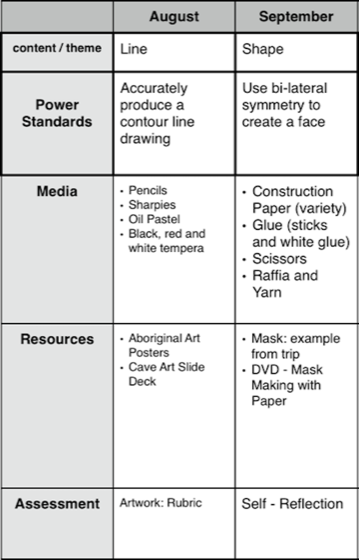We’ve all been there. You are sitting in the middle of a glaze project and you run out! To get more will involve a purchase order, a long wait, and a grumbling scowl from your secretary. That is, assuming you have money left in the budget to purchase it. To make things worse, the glaze will never arrive in time for students to finish the project before break.
Because our orders are often placed well ahead of time, there is some serious planning involved. Although a ton of work up front, this planning has the potential to give you some serious peace of mind, too!
There will be standard items on the ordering list that are no-brainers: paper, glue, favorite tempera, and watercolors. However, there are also other sneaky specialty supplies that we use less often. If forgotten, these can put us in a pinch mid-year.
The solution? Align your supply list with your curriculum maps!
While you are tediously mapping out your big ideas, units, and lessons and aligning them to state and national standards, consider including supplies and materials.
For each unit or lesson, provide yourself a detailed breakdown of the supplies you will need. I like to include two different sections when mapping out supplies. One is a column for consumables I need to order. The other is a column where I note resources I need to pull out such as a DVD or poster to share. Adding a column for resources jogs your memory so you don’t forget to pull out the engaging supplements for your lessons.

You will want to keep a detailed inventory of your consumables and a “wish list” of resources you would like to add to your collection over time.
Once you have all of your supplies aligned with your curriculum, tackle the four-step inventory process outlined below.
1. Using your supply list, determine what you will need for next year.
This idea is pretty straightforward. You may want to make two lists, one for the basics, and one for the odd items that are only used once a year.
2. Take inventory of what you already have.
Using your first list, take inventory of what you already have, what you are low on and what you are completely out of. Then, cross-reference that information with your master list. Doing this while physically in your classroom is valuable because you can actually COUNT the paper. “Ok, I have 5 packs of purple paper left, I don’t need to order a million more.” This will save you money and help you to buy only what you really need.
3. Keep old orders archived in spreadsheets for reference.
You will notice that your orders don’t change that much from year to year. I always need glue, paints, pencils, erasers and paper. Why reinvent the wheel? Just modify the wheel.

4. Keep track of inventory throughout the year.
To make the inventory process even smoother, keep a running tally throughout the entire year as you use up supplies.
One great trick for a running inventory is from AOE’s Senior Editor, Amanda Heyn. She uses a simple spreadsheet that she tapes to the cupboard where she keeps glazes. Knowing what you started with and what you used will also help you save costs by not ordering too much of something you already have on hand. Read more about her process and download a copy of your own glaze inventory sheet right here.

Ordering, receiving and putting away all of those supplies can be pretty daunting, but it also feels good to know you are organized and prepared for the year. The most important thing is to find a system that works for you!
How do you make sure to have enough supplies to get through the year?
Do you plan anything else along with your curriculum?
Magazine articles and podcasts are opinions of professional education contributors and do not necessarily represent the position of the Art of Education University (AOEU) or its academic offerings. Contributors use terms in the way they are most often talked about in the scope of their educational experiences.




